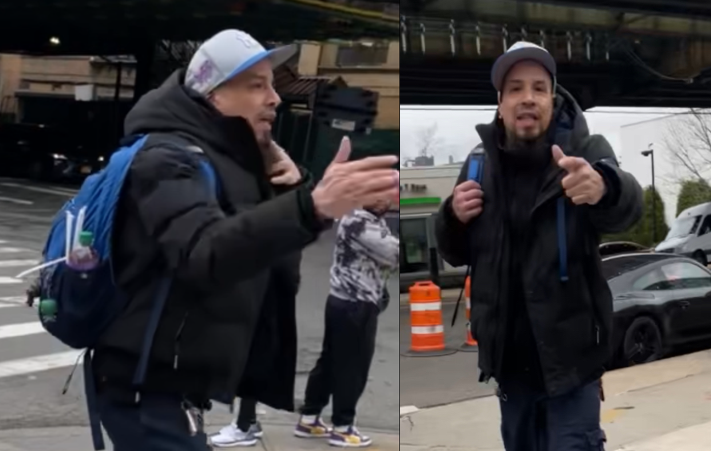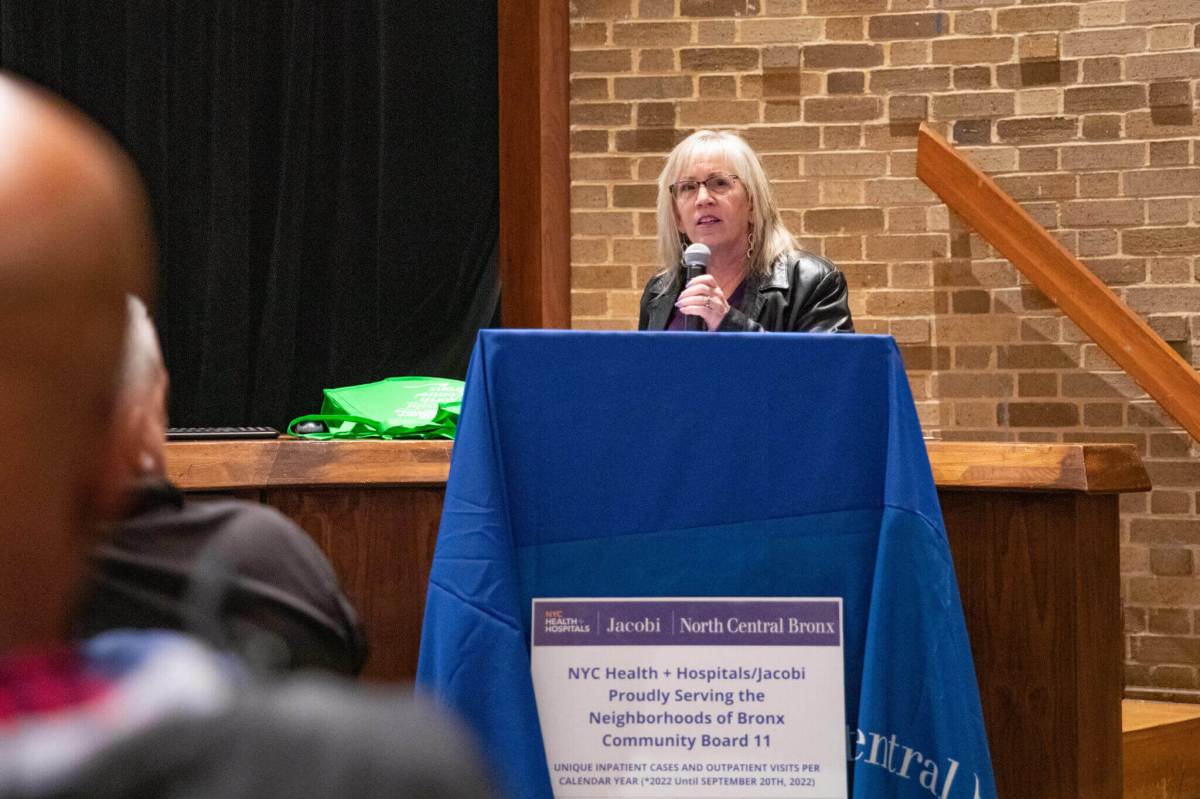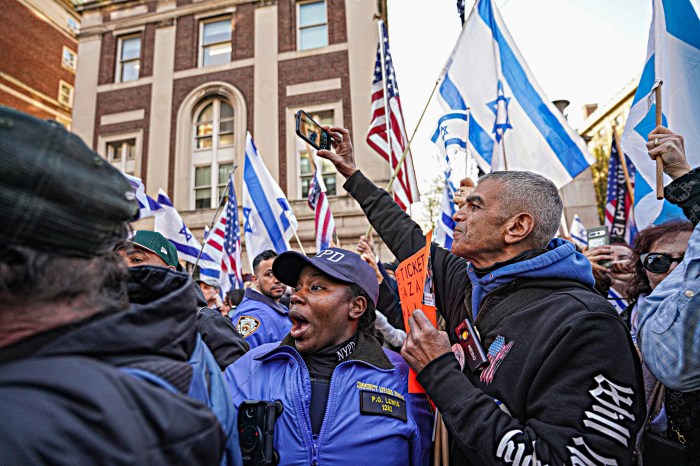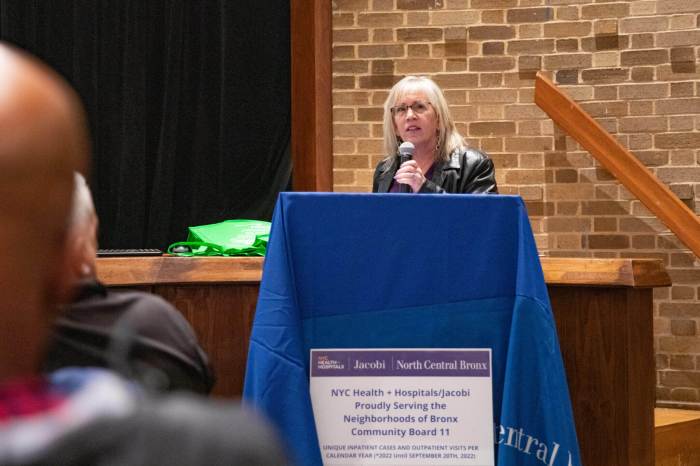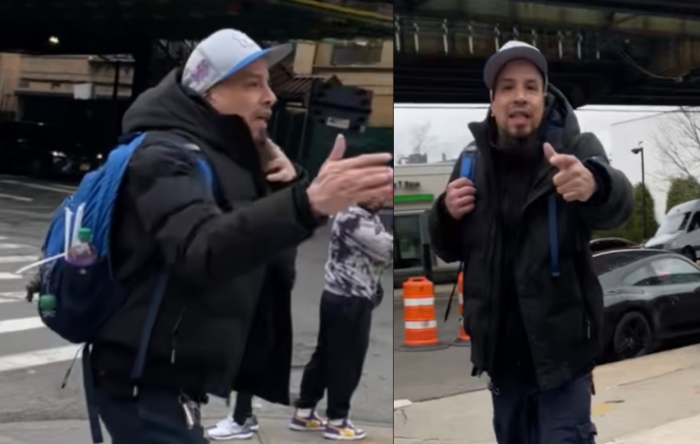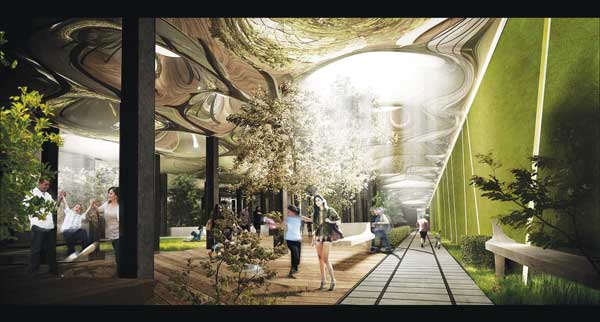 [/media-credit]
[/media-credit]
“Thousands of people go by this location every day and have no idea what is down there,” said Ramsey, principal of Raad Studio, 155 Chrystie St. What is “down there,” visible to the naked eye in the Essex St. station, across the tracks from the Downtown J, M and Z lines, is a vast, rectangular cavern with 20-foot-high vaulted ceilings, columns, residual cobblestones and crisscrossing rail lines. But what Barasch and Ramsey, both 34, envision for the 60,000-square-foot, three-block-long, 1.5-acre space (a little smaller than Gramercy Park), is an exciting opportunity to implement cutting-edge solar technology as well as advance economic revitalization in a neighborhood in short supply of green space.
The project, which has already been nicknamed “The Low Line,” coalesced around Ramsey’s professional and personal interests. He and his eight-person design team have been working on solar technology for several years, involving concentrating sunlight in a sky collector and sending it through fiber optic cables, which then redistribute it to another location. During the recent economic turndown, Ramsey related that he had a lot of downtime to explore his fascination with converting subsurface spaces into public use.
“There are a ton of underground spaces that no one knows about lurking under the city,” he said. “It’s super-compelling, sort of Indiana Jones, to discover these things.” As he was researching these lost, abandoned spaces, he discovered there was one just a few blocks from his office. It was a trolley turnaround, built at the same time as the Williamsburg Bridge, in 1903. It was designed as a depot when streetcars were the main mode of transport over the bridge from Williamsburg to the Lower East Side. The streetcars would go underground, turn around and head back over the bridge.
“Wouldn’t it be cool if we used this technology we’re working on to irrigate sunlight into the space, so we could light it up?” mused Ramsey at the time. “It would save electricity, reduce carbon emissions and generate the capacity for greenery to thrive indoors.” The idea snowballed from there. His self-termed “mad scientists’ laboratory” came up with some images, “which gave me goose bumps,” said Ramsey, who worked on satellite technology at NASA for several years. “It was such compelling design as architects and designers,” he said. “It’s really a fairly straightforward concept, but it definitely feels like it’s from the future.”
Ramsey, who lives on a small street near the Holland Tunnel, started talking to friends. Chief among them was Barasch, an East Villager, who most recently worked for an N.G.O. that promotes the social-innovative uses of technology.
“Dan has a background that is complementary and relevant to making this real,” said Ramsey. Two years ago, they formed a partnership.
The more they researched the idea, the more they realized how important it would be for the neighborhood.
“The Lower East Side is the least green part of the city,” Barasch noted. “That is animating us the most. The main thing we are holding on to is how we could contribute to a new community space that is beautiful, green and does something really innovative with technology, and is open and free to the public, as opposed to all the other things that could happen to the space. Real estate is expensive, and developers are always looking to maximize profit per square foot. Public space usually loses.”
So far, they have received an enthusiastic response from people in the community. They have garnered the official support of the Tenement Museum and Russ & Daughters and a local bar, and they are expecting more endorsements to be announced in the next few weeks.
“They said it could be transformative, a source of pride, and drive more people into the mom-and-pop shops,” Barasch said.
Barasch and Ramsey have had meetings with the Lower East Side Business Improvement District, Community Board 3 and a slew of local officials.
“There are a lot of different communities, like the business community, affordable housing advocates, artists, restaurateurs, and we need to listen to them,” Ramsey said. “Part of our proposal is not to specifically dictate what’s going to be going on in the space.”
Gulick Park (a.k.a. Sheriff Park or Elephant Park), bordered by Delancey St. and Bialystoker Place, is their role model.
“The revitalization and renovation was spearheaded by people who live next to it,” Ramsey noted of that park. “They had design charettes and brainstorming sessions on how the community wanted the space to be used.”
“Some of the best design is to create a beautiful space and then allow the uses to come after it’s built,” Barasch added. However, they envision a gathering space for locals and a magnet destination for the Lower East Side, much the way the 1.5-mile High Line is for the Meatpacking District and Chelsea.
“It mirrors in some ways the evolution of the High Line — the economic opportunities and aesthetics,” Barasch said. Joshua David and Robert Hammond, the creators of the High Line, have been important advisers. “They had a lot of opposition at the very beginning. But at least we don’t have a mayor who is actively opposed to it,” said Barasch.
They have met with senior officials in the Bloomberg administration, whom they say are fans of the idea. (Barasch worked for the mayor on economic development policies for a year.)
“They are cautiously optimistic and looking for us to do more work and to show we have the support of the community,” Barasch said. “We are launching our Kickstarter campaign on Feb. 7, so the community can directly contribute and get involved in ways big and small. We want to make sure all political stakeholders are brought into the process. We are also seeking to raise $500,000 for engineering studies, tech demo construction and cost / benefit research.”
One major hurdle is that the space is owned by the Metropolitan Transportation Authority. Not even Joseph Lhota, the agency’s head, knew the site existed before Ramsey and Barasch started talking it up. Since then, officials from numerous city agencies and local politicians have gone down there, with an M.T.A. escort. Councilmember Margaret Chin has already met with Ramsey and Barasch several times.
“The Delancey Underground project has the potential to transform the Lower East Side by turning something unused into world-class, publically accessible open space,” Chin said. “We are in desperate need of park space on the Lower East Side, and although this project is years in the making, I am very excited for what it could mean for our community. Dan and James are committed to making this a reality for residents of the L.E.S. The technology, innovation and imagination that have gone into the planning of this project are truly amazing. The organizers of the project have been proactive in reaching out to the local community board and our office. I want to go on record as saying I fully support this project and I am committed to seeing it succeed.”
Ultimately, though, the two young visionaries would need to convince the cash-strapped M.T.A. — in the process of selling off some of its assets to produce revenue — that the space should be for public use.
“They could, if they wanted to, pitch this to a big-box store or parking lot and generate money that way,” Barasch said. “We are saying, no, we want this not only to be profitable for the agency, but it also needs to be something that serves the community.”
He admitted that it’s a challenge.
“How do we do both?” he asked. “I love public transportation and want to help these guys keep the lights on. But sometimes we really need to move beyond the short-term view of what’s beneficial and say, ‘What’s the long-term value?’ ” Barasch pointed out that other cities, such as Paris, Stockholm and Moscow, have invested in their underground for public use, so why can’t it be done here?
“You can be in the subway and see a park, and be in a park and see a train roll by,” he said, envisioning the space. “It would be the quintessential New York experience.”
On Thurs., Feb. 16, at 6:30 p.m., Barasch and Ramsey will make a public presentation at the Tenement Museum, 103 Orchard St. (southeast corner of Delancey St.) on “From High Line to Low Line: Building an Underground Park Beneath Delancey Street.” Joining them will be Stuart Blumin, an urban historian and retired professor from Cornell University, who will discuss the historical reasons for the lack of public space on the Lower East Side, and Dave Bolotsky, who spearheaded the effort to restore and transform Gulick Park. Admission is free, and community members are especially invited to attend and meet the plan’s two co-founders. R.S.V.P. at events@tenement.org. To contact Barasch and Ramsey, e-mail media@delanceyunderground.org .










